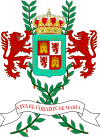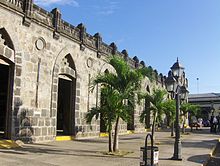- Masaya
-
This article is about the capital city of the Masaya department of Nicaragua. For other uses, see Masaya (disambiguation).
Masaya — Municipality — 
Flag
SealLocation in Nicaragua Coordinates: 11°58′N 86°06′W / 11.967°N 86.1°W Country  Nicaragua
NicaraguaDepartment Masaya Department Area - Total 55.1 sq mi (142.6 km2) Population (2005) - Total 146,000 Masaya, culturally known as the City of Flowers, is the capital city of Masaya department. It is situated approximately 14 km west of Granada and 31 km southeast from Managua. The town of Masaya is situated just East of Masaya Volcano (Volcan de Masaya), an active volcano from which the city takes its name. The 2005 population estimate was 146,000.
Contents
Production
Masaya is located centrally to a large agricultural production region in Nicaragua. Much of the production from the departments of Masaya and Carazo and the surrounding areas is shipped through Masaya on its way north, towards Managua and Leon. Masaya is also a notable industrial center, producing footwear and clothing. Other industries in the city include the processing of fiber and the manufacture of cigars, leather products, soap, and starch. Many of the communities surrounding Masaya produce hardwood and wicker furniture, and there is a neighborhood in Masaya near the lake dedicated to the production of hammocks.
Attractions
Masaya is known as "The Cradle of Nicaraguan Folklore" and is the very heart of Nicaraguan handicrafts. The main market in Masaya is located next to the central bus station. The market is divided into sections, with each section serving a different need. Aside from unique Nicaraguan products such as hand woven hammocks, embroidered blouses, wood carvings, and hemp weaving the market is very diverse. An entire section of the market is dedicated to selling electronic devices and clothing, while another area is reserved for raw meat. Everything is available in the market from hardware and beauty supplies to produce from the surrounding area.
The Mercardo de Artesanias (Craft Market) is located inside what used to be the "mercado viejo" (old market), a 1900s structure that is located near the center of the city and a couple of blocks away from the general population market. This market has been revitalized and set as a tourist spot, where crafts from Masaya and other areas of Nicaragua can be found. In addition, every Thursday night there is a Noche de Verbena or Night of Revelry, where folkloric dances are presented.
Masaya is noted for the annual fall fiesta of San Jerónimo, which is rooted in the Roman Catholic faith of the people who celebrate their patron saint, San Jerónimo. Although many people, including some Nicaraguans, may consider this event a cultural event without participating in the religious content, the vast majority are rendering their devotion to their saint when they participate in the folkloric dances and other street processions, such as the carnivalesque "Torovenado" celebrations, which often have groups and individuals who perform satires of local and national political figures. This celebration is famous within the country to the extensiveness (~ 3 months) and richness of folkloric elements.The historical city center has open plazas and two large 16th Century baroque architecture churches the Assumption's Parish Church, and St Gerome's Church. But there are other colonial gems like St John's, St John Bosco's, and St Michael's.
Masaya Volcano
Main article: Masaya VolcanoVolcán Masaya National Park is popular tourist site. It has a small museum and tourist information. Tour guides and proper equipment are provided for treks inside bat caves created by lava flows from past eruptions. Today, lava can be visible in the volcano’s crater. Masaya is the most active volcano in the region. It is actually made up of two volcanoes: Masaya and Nindirí with a total of five craters. The Spanish first described the volcano in 1524 and believed the belching lava to be melting gold. But when Fray Bartolomé de las Casas first saw it called it the "Gates of Hell". Since then, Masaya Volcano has erupted at least 19 times. From 1965 to 1979 the volcano contained an active lava lake. The last reported eruption event was in 2003, when a plume reportedly shot ~4.6 km into the air. Masaya is an unusual basaltic volcano because it has had explosive eruptions. An eruption in 4550 B.C. was one of the largest on Earth in the last 10.000 years.
Apoyo Lake
The City of Masaya is also located West of a large, deep crater lake named "Apoyo". Part of the Apoyo Lagoon Natural Reserve, this lake is a popular attraction in the area, and is host to several hostels and small resorts. Apoyo's crater measures four miles wide and over 656 feet deep. It is used for fishing as well as water sports. It has also been a location for pre-colonial archaeological findings.
Coyotepe Fortress
Coyotepe is an old fortress located on a sharp hill from where it takes its name which has now been converted into a museum. Built at the turn of the 20th century by President José S Celaya, this site witnessed a fierce battle between national troops and invading U.S. Marines in 1912. Dictator Anastasio Somoza rehabilitated the fortress in the late 30's as a prison where political opponents or anyone suspected of plotting received particularly cruel treatment or the death penalty. Also General Benjamín Celedón was killed by the age of 33 and his dead body dragged from a trotting horse to instill fear among the population and to prevent a potential uprising. But quite on the contrary, Celedón death was the spark that inspired Augusto C Sandino and other famous figures to fight for 7 years in the Segovias in the Northern Nicaragua mountains against the cruel invaders. For many years Coyotepe remained a military outpost but it was given away to the Boy Scouts Association by the 70's. However, after the Nicaraguan Revolution of 1979, the communist government directed by the FSLN seized the site and turned it into a prison where it kept its opponets. The fortress has 43 jail cells, 28 of them on the upper floor, where windows let the air and sunlight in. Each of the upper floor cells could contain from 15 to 20 prisoners, sometimes even more. The basement cells, on the other hand, resembled a dungeon for they were dark, damp, stuffy, and cramped so prisoners would lose track of time and inevitably ended up with psychological trauma. In all, there were about 1,000 prisoners at any one time. Nevertheless as time went on, the site was abandoned from 1983 to 1992. During that period, there were rumours among the population that Coyotepe was used as a sanctuary for Satanic practices for there was no proper security. Finally, the new democratic governments that won the elections in 1990, finally returned Coyotepe to the Boy Scouts Association.
Gastronomy
Masaya boasts a varied culinary tradition based on pre-Columbian recipes. However, the most famous Masayan dishes are Nacatamal, Vaho, and yucca. Nacatamal, is a giant tamal so it's a full meal on its own right. Nacatamals are made of corn flour sprinkled with annato and salt, and mixed with pork, bacon, a bit or rice, potato slices, onions, tomatoes, green peppers, mint, Congo chilis, and prunes. Then everything is covered in plantain leaves, tied up with ropes, and boiled for a couple of hours on a giant pot. Due to their large size, Nacatamals are normally eaten at breakfast or supper with a loaf of bread and black coffee to help with digestion. Now, Vaho is another heavy, hearty meal. So it is normally eaten at lunch to allow for digestion the rest of the day. It consists of thick, long slices of cecina (salted, dried beef) marinated in sour orange juice. Then, the cecina is mixed with yucca, green plantains, ripe plantains, tomatoes, onions, garlic, cabbage, and placed on a pot with the interior walls covered in plantain leaves. Then, everything's cover up with the same leaves and a lid, and steam-cooked very slowly. Vaho is eaten with a side of big, thick Nicaraguan tortillas, and a light natural fruit drink like linaza, chía, or maracuyá. Yucca is a tuber with brown, scaly skin and a pure white flesh. It can be boiled, steamed, fried, or broiled and used for different dishes like Vigorón which is boiled yucca, topped with sweet-and-sour Nicaraguan salad made of cabbage cut into strips, diced tomatoes, onions, green currants, Congo chilis, vinegar, and salt.
Famous People
_National Hero, General Augusto C Sandino, born in Niquinohomo, on may 18, 1895. Assesinated in a plot carried out by the head of the National Guard and future dictator Anastasio Somoza García on february 21, 1934 at Chipote Hill, 2 km East of Managua's downtown.
_Former President Enrique Bolaños, born in the City of Masaya on May 13, 1928.
_Writer and intellectual Sergio Ramírez, born in Masatepe on August 5, 1942.
_José Ramírez, a member of guitar trio The Pinoleros, also from Masatepe.
Benemérito Cuerpo de Bomberos de Masaya
Town twinning
 - Belo Horizonte, Brazil
- Belo Horizonte, Brazil - Dietzenbach, Germany
- Dietzenbach, Germany - Leicester, England, UK
- Leicester, England, UK - Nijmegen, The Netherlands
- Nijmegen, The Netherlands - North Plainfield, New Jersey, USA
- North Plainfield, New Jersey, USA
External links
Works cited
1http://volcano.und.edu/vwdocs/volc_images/south_america/masaya.html
Coordinates: 11°58′N 86°06′W / 11.967°N 86.1°W
Capital: Masaya Municipalities Catarina · La Concepción · Masatepe · Masaya · Nandasmo · Nindirí · Niquinomo · San Juan de Oriente · TismaCategories:- Populated places in Nicaragua
- Municipalities of the Masaya Department
Wikimedia Foundation. 2010.




